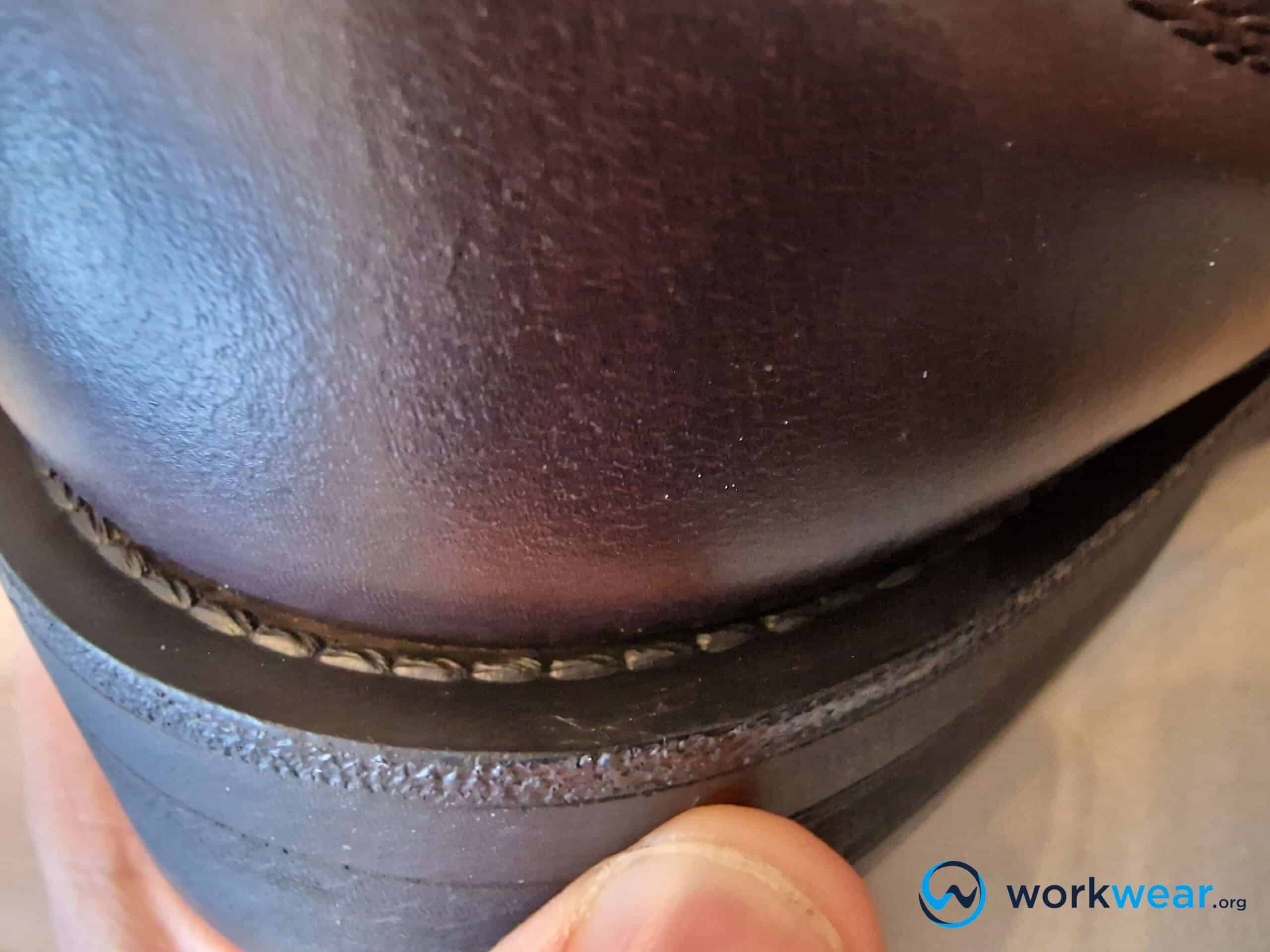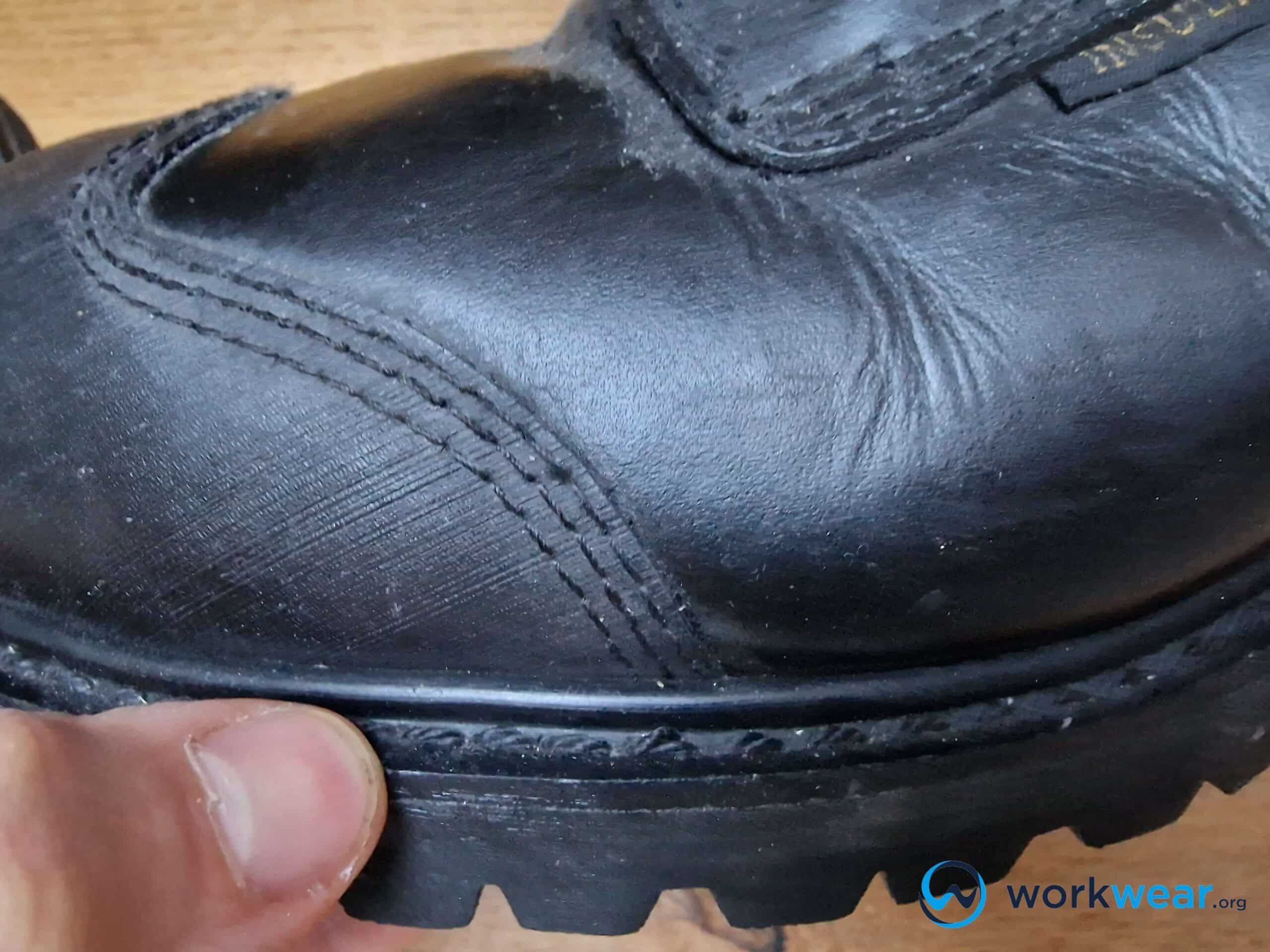Faux Stitching vs Genuine Stitching in Footwear

High-quality stitching is one of the signs of sturdiness in work boots and other footwear. If you look more closely, you might discover that the stitches on certain sections of boots are actually just accents simulating real stitches. What’s faux stitching, and how does it compare with genuine stitching on footwear? I’m here to shed light on this topic as we look at how faux stitches differ from genuine stitches on footwear and if there are similarities between the two.
Definitions
Faux stitching is designed to mimic genuine stitching on footwear closely. It’s typically found on boots with uppers attached to the soles by adhesives – such as in footwear built with cement construction. Since they look just like real stitches, faux stitches can be quite deceiving, especially to the untrained eye. Faux stitching is placed on the area between the sole and upper, where real stitches are supposed to go to keep the two components firmly attached. Faux stitching can be discovered through close inspection, which will reveal that the “stitches” are just sitting on the edge of the sole and not through both the sole and upper.
On the other hand, genuine stitching goes through the sole and upper, securely attaching the two sections. The easiest way to determine if the boots have genuine or faux stitching is to check if the stitches are visible on top and under the sole. Based on our experience, premium and especially handmade work boots always have genuine stitching.
Winner: Faux and genuine stitching are both winners in appearance because they look the same, giving the impression of superior quality and strength to the boot design.
Price
Genuine and faux stitching affect how boots’ uppers and soles are attached. However, when it comes to the main work footwear brands, they do not directly and significantly impact footwear prices, which are more closely affected by other qualities. For example, the Timberland Premium Boot has faux stitching between the sole, but its price is quite high due to other features such as waterproofing and insulation. This differs from handmade boots, as virtually all of them have genuine stitching between the upper and sole. After all, the craftsmanship and authenticity of genuine stitching are some of the things that handmade boots are all about!
Winner: Genuine and faux stitching don’t significantly affect the prices of work boots made by major brands. However, handmade work boots almost always feature genuine stitching, and this is one of the factors that justifies their higher.
Main Differences
Strength and Durability
Genuine and faux stitches may look alike, but there’s a vast difference in how they affect the boots’ strength and durability. Genuine stitching connects the leather upper and the sole, ensuring they’re strongly bonded. It prevents the boots from falling apart prematurely, especially if used for strenuous activities and challenging conditions. Boots with genuinely stitched seams generally last longer than those with faux stitching. The stitched seams also help with water resistance, particularly if a welt is placed between the upper and sole to stop liquid absorption further.
Faux stitching, on the other hand, has no positive effect on the boots’ strength and durability. It’s placed on boots purely for aesthetic purposes, giving the impression of reliable strength and quality associated with sturdy (real) stitches. Since the stitches sit on the upper edges of the soles, they don’t secure the component to the uppers, reinforce the footwear, or protect it from premature damage.
Winner: Genuine stitching is the undisputed winner regarding strength and durability. It secures the upper and sole together, enhancing the footwear’s sturdiness and lasting performance – unlike faux stitching which works for purely aesthetic purposes.
Water Resistance
Genuinely stitched seams on boots can help improve water resistance. Boots built with securely stitched seams between the sole and upper stop liquids from quickly entering, especially if the construction method (such as Goodyear welting) includes using a welt. The combination of real, strong stitching and welt form a barrier against wet elements, which are prevented from seeping into the boots. This results in boot interiors (and feet) that stay dry in wet environments.
On the other hand, faux stitching does nothing to improve boots’ resistance to liquids. Fake stitches are solely decorative and don’t secure the upper to the sole as real stitches do. Non-waterproof footwear options that only have faux stitching generally have weaker water resistance than those with soles that are genuinely stitched to the uppers.
Winner: Genuine stitching improves the boots’ resistance to liquids. This is especially true with welted construction methods, further strengthening the boot’s ability to block moisture.
Material
Real and faux stitches typically use different materials, even if they look alike. Genuine stitches on boots typically use high-performance threads to bond the uppers and soles together. These materials are more durable than ordinary sewing threads. They’re designed to last while holding the sections together, enhancing the boots’ resilience against damage. Some boots even use exceptionally strong materials – such as Kevlar – to reinforce the bond between the uppers and soles of heavy-duty work boots further.
Conversely, faux stitches don’t use top-notch materials. Since they’re not designed to hold the uppers and soles together, they don’t need to be particularly strong. In some cases, faux stitching is made of plastic, which can be detected and confirmed only upon close examination.
Winner: Genuine stitching wins with high-quality, durable materials that reinforce the connection between the uppers and soles of footwear.
Comparison table
| Fake Stitching | Genuine Stitching | |
| Appearance | Good | Good |
| Price | Low to Medium | Medium to High |
| Strength & Durability | Weak | Good |
| Water Resistance | Weak | Good |
| Material | Typically, of lower quality | High quality, and strong |
Who's the Overall Winner
Genuine stitching is the clear winner in this match-up. It trumps faux stitching in terms of strength and durability, water resistance, and quality of materials. It’s worth noting that faux and genuine stitches look the same, so they have the same effect on boots’ appearance.
Recap
Choose boots with faux stitching if you:
- Are not particular about footwear durability
- Work in mostly dry conditions
- Don’t mind fake stitching on boots
Pick boots with genuine stitching to:
- Enjoy better foot protection against liquid absorption
- Have work boots that are likelier to last longer
- Ease your mind that the boots’ uppers and soles are securely attached
Personal Testing Experience
Here are the things I observed while using two high-quality work boots – one with genuine stitching and the other with faux stitches. The Caterpillar Fairbanks Steel Toe Work Boot had strong, genuine stitching holding the upper and sole together. It had steel toe caps that shielded the toes against heavy falling or rolling objects to prevent severe crushing injuries. The footbed used a combination of EVA and memory foam that cushioned the foot against the impact of walking on hard surfaces without adding too much weight to the boot. Just below the collar, special pods created padded areas that kept the ankle from being harmed by impact and abrasion. The boot’s high-grip outsole prevented slipping on tricky surfaces. This boot isn’t waterproof, so it’s not ideal for wet environments. On the other hand, the Timberland 6-inch Premium Waterproof Boot came with faux stitching on the sole, but the seam-sealed construction enhanced water resistance. This waterproof construction ensured all-day foot dryness in wet settings. The leather collar was generously cushioned, stabilizing the ankle in place and protecting it from getting bruised by rough objects and mild impact. The exclusive anti-fatigue technology absorbs the shock resulting from continuous walking to stop the development of foot fatigue. The outsole had strong traction that steadied the steps in challenging ground conditions. The boot was hard to pull on and off, and the faux stitching did nothing to secure the upper and sole together.
Conclusion
It’s difficult to distinguish between genuine and faux stitching just by looking at them, but it’s worth knowing the qualities that set them apart. Genuine stitching excels in strength and durability, water resistance, and quality of materials. Both stitching types deliver the same aesthetic effect because they look alike but have no direct impact on footwear prices.
FAQ's
- Are all faux stitches made of plastic?
- No, some faux stitches are made of real threads, although they only sit on top of the sole.
- Are boots with genuine stitching always more durable?
- Not necessarily. Genuine stitching can reinforce the bond between the upper and the sole. However, other aspects – such as construction methods and quality of materials – will have a stronger impact on the boots’ overall performance and durability.
- Why is faux stitching used on footwear?
- Faux stitching is used for aesthetic purposes and often to give the impression of better strength, as the sole is made to look like it’s stitched to the upper.
- What construction methods use genuine stitching in work boots?
- Some construction methods that use genuine stitches in work boots include Goodyear Welt, Blake stitching, Stitch-down, and Strobel.
678+
Products Reviewed
24+ Years
Combined Experience
500+ Hrs
Field Testing






